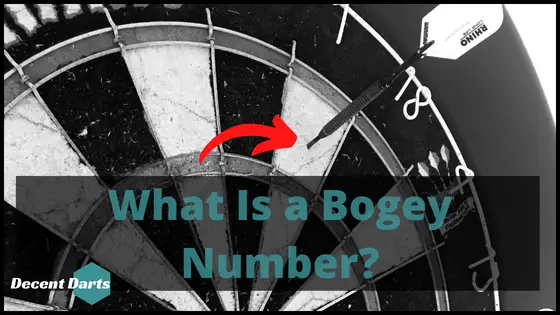In darts, high scoring is important and is something that many people place the majority of their focus on but finishing is what will win you games. As the great Bobby George often said:
“Trebles for show, doubles for dough”
Bobby George
Meaning treble 20s, 180’s, and high scoring look good for the fans and inflate your averages but if you can’t hit a double to finish, you won’t be winning any games (or prize money)!
Therefore, checking out is crucial and most players are hopefully aware of checkout options available but one issue you might stumble across when trying to finish is that you accidentally land on a bogey number.
But what is a bogey number in darts? Read on as we cover what a bogey number is in darts and why you should avoid them as much as possible. This will improve your odds of leaving a favorable checkout and more importantly, increase your chances of winning a game!
What Is a Bogey Number in Darts?
A bogey number is a number that you cannot finish or check out on depending on the number of darts you have left to throw on a single round. Bogey numbers can be with either 1, 2, or 3 darts.
These numbers are well known to the professional players who will know every pitfall if they fail to hit specific checkouts, so they will ensure they avoid them at all costs.
However, for a beginner or casual player, these bogey numbers can often come into play due to inaccuracy of the throw or poor counting when trying to checkout or finish.
Bogey numbers can be attributed to four, five, six, and more darts, but because of the massive variations in possible scoring with those darts, it tends to be more frequently mentioned with 1,2, or 3 darts. There are if you include up to 8 darts, 77 numbers in total.
1 Dart Bogey Numbers
The following numbers cannot be checked out with one dart. This is because you can only score a maximum of 50 or bull to finish with one scoring dart so any number above 50 is irrelevant as it can’t be used as a checkout.
There following are therefore bogey numbers below 50 in descending order which cannot be used to checkout with 1 dart and is therefore considered bogey numbers.
- 49, 48, 47, 46, 45, 44, 43, 42, 41.
- 39, 37, 35, 33, 31, 29, 27, 25, 23.
- 21, 19, 17, 15, 13, 11, 9, 7, 5, 3, 1.
2 Dart Bogey Numbers
With 2 darts the bogey numbers decrease as the availability of options increases with two darts as opposed to one. So, with 1 dart you cannot finish on an odd number but with two darts in hand, you are able to score with one of your darts on an odd number leaving you an even number to finish on.
So here are 2 dart bogey numbers:
- 109, 108, 106, 105, 103, 102, 99
As an example, if you have 101 remaining and 2 darts – you can hit a treble 17 (51 points) and checkout on the bull (50 points) but if you have 102 remaining you can’t checkout with 2 darts. The highest score would be treble 20 (60 points) but this would leave you on 42 so no finish so 102 is a 2 dart bogey number.
3 Dart Bogey Numbers
The biggest check out with 3 darts is 170 so bogey numbers will always start below that.
The 3 dart bogey numbers are:
- 169, 168, 166, 165, 163, 162, 159.
It’s important to remember that although bogey numbers may seem irrelevant especially when you start out a game, by landing on any of them you immediately give your opposition a chance to win by affording them more darts.
As you can’t finish on a bogey number (whether with 1, 2, or 3 darts) you’ll be forfeiting the current throw and giving your opponent an opportunity to either checkout on a finish themselves or leave themselves on a finish for the next throw.
Therefore, if you avoid bogey numbers your chances of checking out more quickly are Increased.
Conclusion
Bogey numbers are not something you come across until you start to play darts a bit more competitively and once you do, you’ll soon realize that you need to avoid them at all costs.
Leaving yourself on a bogey number (due to a missed dart or not knowing what a bogey number is) will instantly reduce your chance of winning a game because you’ll need to throw an extra dart than necessary to leave a finish.
If you have a score of 42 and throw for a single 2 (to leave double 20) but hit a single 17, you’ve left yourself on 25 which is not an outshot. Therefore you need to throw an extra dart just to leave a finish and this will always give your opponent an advantage.
Therefore, learn the bogey numbers above and try to avoid them at all times once you reach a 3, 2, or single dart finish – your win percentage will surely improve as a result!
If you’ve read this and feel more confident now knowing that you can avoid bogey numbers and increase your chance of winning, you might also want to check out what a bust is in darts. This is something else that can leave reduce your chances when it comes to finishing and is, therefore, something you definitely want to avoid.

